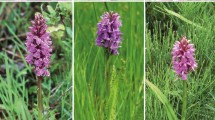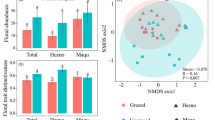Abstract
Dioecious species are dependent on pollen vectors for sexual reproductive success. Male and female plants can express different blooming strategies, which respectively favour pollen donation and reception. This study characterised the flowering phenology of ten dioecious species, with different floral resources and pollination systems. The study focused on an area of sandy coastal plain in southeastern Brazil. We evaluated flowering events of male and female plants, in addition to the distribution of species flowering periods over 2 years. Regardless of the dependence upon biotic pollinators, all species shared the following traits: a single or a more expressive flowering event per year, with a duration ranging from intermediate to long, a high percentage of activity and intensity and high synchronism rates for intra- and inter-sexual morphs. In most species, males flowered first and more intensely following a sex allocation perspective. The flowering periods of dioecious species were randomly distributed throughout the year, preventing the identification of phenological drivers. The results suggest that the biotic (floral resources, pollen vector), abiotic (temperature, precipitation, day length) and phylogenetic factors do not seem to explain the observed flowering strategies. Since the restinga is a geologically recent tropical environment, the phenological attributes of the dioecious species possibly reflect the individual patterns of colonising species more than it does the interactions among them and with the environment.




Similar content being viewed by others
References
Albuquerque AA, Lima HA, Gonçalves-Esteves V, Benevides CR, Rodarte ATA (2013) Myrsine parvifolia (Primulaceae) in sandy coastal plains marginal to Atlantic rainforest: a case of pollination by wind or by both wind and insects? Braz J Bot 36:65–73
Amorim W, Oliveira PE (2006) Estrutura sexual e ecologia reprodutiva de Amaioua guianensis Aubl. (Rubiaceae), uma espécie dioica de formações florestais de cerrado. Rev Bras Bot 29:353–362
Araújo DSD (2000) Análise florística e fitogeográfica das restingas do estado do Rio de Janeiro. Ph.D. Thesis, Universidade Federal do Rio de Janeiro, Rio de Janeiro
Augspurger CK (1983) Phenology, flowering synchrony, and fruit set of six neotropical shrubs. Biotropica 15:257–267
Barrett SCH (2002) The evolution of plant sexual diversity. Nat Rev Genet 3:274–284
Barrett SCH (2010) Understanding plant reproductive diversity. Philos Trans R Soc Lond B 365:99–109
Bawa KS (1980a) Evolution of dioecy in flowering plants. Annu Rev Ecol Evol Syst 11:15–39
Bawa KS (1980b) Mimicry of male by female flowers and intrasexual competion for pollinators in Jacaratia dolichaula (D. Smith) Woodson (Caricaceae). Evolution 34:467–474
Bawa KS (1983) Patterns of flowering in tropical plants. In: Jones CE, Little RJ (eds) Handbook of experimental pollination biology. Scientific and Academic Editions, NewYork, pp 394–410
Bawa KS, Crisp JE (1980) Wind-pollination in the understory of a rain forest in Costa Rica. J Ecol 68:871–876
Bawa KS, Perry DR, Beach JH (1982) Reproductive biology of tropical lowland rain forests trees. I. Sexual systems and incompatibility mechanisms. Am J Bot 72:331–345
Bencke CSC, Morellato LPC (2002a) Estudo comparativo de nove espécies arbóreas em três tipos de floresta atlântica no sudeste do Brasil. Rev Bras Bot 25:237–248
Bencke CSC, Morellato LPC (2002b) Comparação de dois métodos de avaliação da fenologia de plantas, sua interpretação e representação. Rev Bras Bot 25:269–275
Benevides CR (2011) Biologia floral e reprodutiva de espécies dioicas na restinga de Maricá, RJ. Ph.D. Thesis, Universidade Federal do Rio de Janeiro/Museu Nacional, Rio de Janeiro
Bolmgren K, Eriksson O, Linder HP (2003) Contrasting flowering phenology and species richness in abiotically and biotically pollinated angiosperms. Evolution 57:2001–2011
Bullock SH, Bawa KS (1981) Sexual dimorphism and the annual flowering pattern in Jacaratia Dolichaula (D. Smith) Woodson (Caricaceae) in a Costa Rican rain forest. Ecology 62:1494–1504
Cesário LF, Gaglianone MC (2008) Biologia floral e fenologia reprodutiva de Schinus terebinthifolius Raddi (Anacardiaceae) em Restinga do Norte Fluminense. Acta Bot Bras 22:828–833
Correia MCR, Ormond WT, Pinheiro MCB, Lima HA (1993) Estudo da biologia floral de Clusia criuva Camb.—Um caso de mimetismo. Bradea 24:209–219
Correia MCR, Ormond WT, Pinheiro MCB, Lima HA (1999) Biologia da reprodução de Clusia lanceolata Camb. Hoehnea 26:61–73
Costa MLMN, Andrade ACS, Pereira TS (1997) Fenologia de espécies arbóreas em floresta Montana na Reserva Ecológica de Macaé de Cima. In: Lima HC, Guedes-Bruni RR (eds) Serra de Macaé de Cima: diversidade florística e conservação em Mata Atlântica. Jardim Botânico do Rio de Janeiro, Rio de Janeiro, pp 169–183
Fenner M (1998) The phenology of growth and reproduction in plants. Perspect Plant Ecol Evol Syst 1:78–91
Forero-Montaña J, Zimmerman JK (2010) Sexual dimorphism in the timing of flowering in two dioecious trees in a subtropical wet forest, Puerto Rico. Caribb J Sci 46:88–95
Fournier LA (1974) Un método cuantitativo para la medición de características fenolólogicas en árboles. Turrialba 24:422–423
Fournier LA, Charpantier C (1975) El tamaño de la muestra y la frecuencia de las observaciones en el studio de las características fenológicas de los árboles tropicales. Turrialba 25:45–48
Frankie GW, Baker HG, Opler PA (1974) Comparative phenological studies of trees in tropical lowland wet and dry forest sites of Costa Rica. J Ecol 62:881–913
Frankie GW, Opler PA, Bawa KS (1976) Foraging behaviour of solitary bees: implications for outcrossing of a Neotropical forest tree species. J Ecol 64:1049–1057
Friedman J, Barrett SCH (2009) Wind of change: new insights on the ecology and evolution of pollination and mating in wind-pollinated plants. Ann Botany 103:1515–1527
Gotelli NJ, Entsminger GL (2001) ECOSIM: Null models software for ecology (version 7.0). Acquired Intelligence Inc. and Kesey-Bear
Köppen W (1948) Climatología. Fondo de Cultura Económica, Mexico City
Kudo G (2006) Flowering phenologies of animal-pollinated plants: reproductive strategies and agents of selection. In: Harder LD, Barrett SCH (eds) Ecology and evolution of flowers. Oxford University Press, Oxford, pp 139–158
Leal DO, Benevides CR, Silva RCP, Sá-Haiad B, Santiago-Fernandes LDR, Lima HA (2013) Garcinia brasiliensis: insights into reproductive phenology and sexual system in a Neotropical environment. Plant Syst Evol 299:1577–1585
Lenza E, Oliveira PE (2005) Biologia reprodutiva de Tapirira guianensis Aubl. (Anacardiaceae), uma espécie dioica em mata de galeria do Triângulo Mineiro. Bras Rev Bras Bot 28:179–190
Lloyd DG (1979) Parental strategies of angiosperms. N Z J Bot 17:595–606
Lloyd DG, Webb CJ (1977) Secondary sex characters in plants. Bot Rev 43:177–216
Mantovani A, Iglesias RR (2001) Bromélias terrestres na restinga de Barra de Maricá, Rio de Janeiro: influência sobre o microclima, o solo e a estocagem de nutrientes em ambientes de borda de moitas. Leandra 16:17–37
Marques MCM, Oliveira PE (2004) Fenologia de espécies do dossel e do sub-bosque de duas florestas de restinga na Ilha do Mel, sul do Brasil. Rev Bras Bot 27:713–723
Morellato LPC (2004) Phenology, sex ratio and spatial distribution among dioecious species of Trichilia (Meliaceae). Plant Biol 6:491–497
Morellato LPC, Rodrigues RR, Leitão Filho HF, Joly CA (1989) Estudo comparativo da fenologia de espécies arbóreas de floresta de altitude e floresta semidecídua na Serra do Japi, Jundiaí, São Paulo. Rev Bras Bot 12:85–98
Morellato LPC, Talora DC, Takahasi A, Bencke CC, Romera EC, Zipparro VB (2000) Phenology of Atlantic rain forest trees: a comparative study. Biotropica 32:811–823
Muenchow G, Delesalle V (1994) Pollinator response to male floral display size in two Sagittaria (Alismataceae) species. Am J Bot 81:568–573
Munguía-Rosas MA, Ollerton J, Parra-Tabla V (2011) Phenotypic selection on flowering phenology and size in two dioecious plant species with different pollen vectors. Plant Species Biol 26:205–212
Newstrom LE, Frankie GW, Baker HG (1994a) A new classification for plant phenology based on flowering patterns in lowland tropical rain forest trees at la selva, Costa Rica. Biotropica 26:141–159
Newstrom LE, Frankie GW, Baker HG, Colwell RK (1994b) Diversity of long-term flowering patterns. In: McDade LA, Bawa KS, Hespenheide HA, Hartshorn GS (eds) La Selva. Ecology and natural history of a neotropical rain forest. Chicago University Press, Chicago, pp 142–160
Niklas KJ (1985) The aerodynamics of wind pollination. Bot Rev 51:328–386
Opler PA, Frankie GW, Baker HG (1976) Rainfall as a factor in the release, timing, and synchronization of anthesis by tropical trees and shrubs. J Biogeogr 3:231–236
Ormond WT, Pinheiro MCB, Lima HA, Correia MCR, Castro AC (1991) Sexualidade das plantas da restinga de Maricá, RJ. Boletim do Museu Nacional, (N. S. Botânica) 87:1–24
Pereira AR, Angelocci LR, Sentelhas PC (2001) Agrometeorologia: fundamentos e aplicações práticas. Editora Agropecuária, Guaíba
Pereira TS, Costa MLMN, Moraes LFD, Luchiari C (2008) Fenologia de espécies arbóreas em Floresta Atlântica da Reserva Biológica de Poço das Antas, Rio de Janeiro, Brasil. Iheringia 63:329–339
R Development Core Team (2014) A language and environment for statistical computing. R Foundation for Statistical Computing, Vienna, Austria. 2014. URL http://www.R-project.org/
Rabinowitz D, Rapp JK, Sork VL, Rathcke BJ, Reese GA, Weaver JC (1981) Phenological properties of wind and insect pollinated prairie plants. Ecology 62:49–56
Rathcke BJ (1983) Competition and facilitation among plants for pollination. In: Real L (ed) Pollination biology. Academic press, New York, pp 305–329
Rathcke BJ, Lacey EP (1985) Phenological patterns of terrestrial plants. Annu Rev Ecol Syst 16:179–214
Rodarte ATA (2008) Caracterização espacial, temporal e biologia floral das espécies de restinga, com ênfase nos recursos florais. Ph.D. Thesis, Universidade Federal do Rio de Janeiro/Museu Nacional, Rio de Janeiro
Scarano FR (2002) Structure, function and floristic relationships of plant communities in stressful habitats marginal to the Brazilian Atlantic rain forest. Ann Bot 90:517–524
Schaik CPV, Terborgh JW, Wrigh SJ (1993) The phenology of tropical forests: adaptive significance and consequences for primary consumers. Annu Rev Ecol Evol Syst 24:353–377
StatSoft Inc. (2005) STATISTICA (data analysis software systems), version 7.1. www.Statsoft.com
Talora DC, Morellato LPC (2000) Fenologia de espécies arbóreas em floresta de planície litorânea do sudeste do Brasil. Rev Bras Bot 23:13–26
Thomas SC, La Frankie JV (1993) Sex, size, and interyear variation in flowering among dioecious trees of the Malayan rain forest. Ecology 74:1529–1537
Varejão-Silva MA (2000) Meteorologia e climatologia. Instituto Nacional de Meteorologia (INMET), Brasília
Vieira FA, Appolinário V, Fajardos CG, Carvalho C (2010) Reproductive biology of Protium spruceanum (Burseraceae), a dominant dioecious tree in vegetation corridors in Southeastern Brazil. Rev Bras Bot 33:711–715
Acknowledgments
We thank Dr. Leonardo Galetto (Universidad Nacional de Córdoba), the editor and the anonymous reviewers for their helpful comments; Angela Arruda e Albuquerque, Emanoela Mano Muniz da Silva and Luciana Carolina Oliveira Sepúlveda do Nascimento for their help in field work. This study is part of the Ph.D. thesis of C.R.B., which was carried out in the Postgraduate Program in Biological Sciences (Botany) of the Museu Nacional, Universidade Federal do Rio de Janeiro (UFRJ), Rio de Janeiro, Brazil and was supported by CAPES (Coordenação de Aperfeiçoamento de Pessoal de Nível Superior).
Author information
Authors and Affiliations
Corresponding author
Rights and permissions
About this article
Cite this article
Benevides, C.R., Rodarte, A.T.A. & de Lima, H.A. Strategies of flowering in dioecious plants in tropical coastal vegetation, Brazil. Braz. J. Bot 38, 585–595 (2015). https://doi.org/10.1007/s40415-015-0164-8
Received:
Accepted:
Published:
Issue Date:
DOI: https://doi.org/10.1007/s40415-015-0164-8




